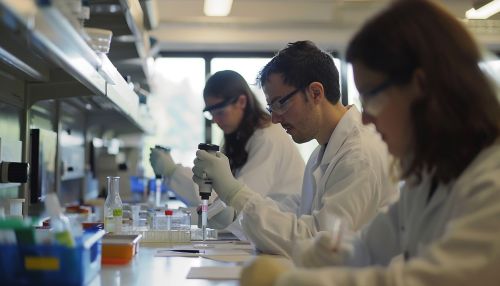Nitric oxide synthase
Introduction
Nitric oxide synthase (NOS) is a family of enzymes responsible for the synthesis of nitric oxide (NO), a critical signaling molecule in various physiological and pathological processes. NO is involved in vasodilation, neurotransmission, immune response, and cellular defense mechanisms. The three main isoforms of NOS are neuronal NOS (nNOS), endothelial NOS (eNOS), and inducible NOS (iNOS). Each isoform has distinct regulatory mechanisms, tissue distributions, and physiological roles.
Structure and Function
Isoforms
Neuronal NOS (nNOS)
Neuronal NOS, also known as NOS1, is primarily expressed in neurons and is involved in the regulation of neurotransmission. It plays a crucial role in synaptic plasticity, learning, and memory. nNOS is constitutively expressed and its activity is calcium/calmodulin-dependent. The enzyme is localized in both the cytoplasm and the plasma membrane, where it interacts with various proteins such as PSD-95, which anchors nNOS to the postsynaptic density.
Endothelial NOS (eNOS)
Endothelial NOS, or NOS3, is predominantly found in endothelial cells lining the blood vessels. It is essential for the production of NO, which mediates vasodilation and thus regulates blood pressure and blood flow. eNOS activity is also calcium/calmodulin-dependent and is regulated by various factors including shear stress, phosphorylation, and interaction with caveolin-1. The enzyme is typically associated with the plasma membrane and caveolae.
Inducible NOS (iNOS)
Inducible NOS, known as NOS2, is expressed in various cell types, including macrophages, in response to inflammatory stimuli such as cytokines and bacterial endotoxins. Unlike nNOS and eNOS, iNOS is calcium-independent and produces large amounts of NO over extended periods. This high-output NO production is crucial for the immune response, particularly in the destruction of pathogens and tumor cells.
Regulation of NOS Activity
Calcium/Calmodulin Dependence
The activity of nNOS and eNOS is tightly regulated by intracellular calcium levels. Upon an increase in calcium concentration, calcium binds to calmodulin, forming a complex that activates these enzymes. This regulation ensures that NO production is closely linked to cellular signaling events that elevate calcium levels.
Phosphorylation
Phosphorylation is a key regulatory mechanism for eNOS. Various kinases, including protein kinase A (PKA), protein kinase B (Akt), and AMP-activated protein kinase (AMPK), phosphorylate eNOS at specific serine residues, enhancing its activity. Conversely, phosphorylation by protein kinase C (PKC) at different sites can inhibit eNOS activity.
Protein-Protein Interactions
NOS enzymes interact with various proteins that modulate their activity. For instance, eNOS binds to caveolin-1, which inhibits its activity. Upon stimulation by shear stress or other factors, eNOS dissociates from caveolin-1, leading to its activation. Similarly, nNOS interacts with PSD-95, which localizes it to the postsynaptic density and facilitates its role in neurotransmission.
Physiological and Pathological Roles
Cardiovascular System
NO produced by eNOS is a critical regulator of vascular tone and blood pressure. It induces relaxation of smooth muscle cells in the blood vessel walls, leading to vasodilation. Dysregulation of eNOS activity is implicated in various cardiovascular diseases, including hypertension, atherosclerosis, and heart failure.
Nervous System
In the nervous system, NO acts as a neurotransmitter and neuromodulator. nNOS-derived NO is involved in synaptic plasticity, a fundamental process underlying learning and memory. Abnormal nNOS activity has been linked to neurodegenerative diseases such as Alzheimer's disease and Parkinson's disease.
Immune System
iNOS plays a vital role in the immune response by producing large amounts of NO, which has antimicrobial and antitumor properties. However, excessive NO production by iNOS can contribute to inflammatory diseases, including septic shock, rheumatoid arthritis, and inflammatory bowel disease.
Clinical Implications
NOS Inhibitors
Inhibitors of NOS enzymes have therapeutic potential in various conditions. For example, selective nNOS inhibitors are being explored for the treatment of neurodegenerative diseases and chronic pain. eNOS inhibitors may be useful in conditions characterized by excessive vasodilation, such as septic shock. iNOS inhibitors are being investigated for their potential to reduce inflammation in autoimmune diseases and chronic inflammatory conditions.
NOS Activators
Activators of NOS, particularly eNOS, have potential therapeutic applications in cardiovascular diseases. Agents that enhance eNOS activity or mimic its effects, such as phosphodiesterase inhibitors and statins, are used to improve endothelial function and reduce the risk of cardiovascular events.
Research and Future Directions
Ongoing research aims to elucidate the detailed mechanisms of NOS regulation and the precise roles of NO in various physiological and pathological processes. Advances in understanding the structure and function of NOS enzymes may lead to the development of novel therapeutic strategies for a wide range of diseases. Additionally, the exploration of NO donors and NOS modulators holds promise for the treatment of conditions such as hypertension, neurodegenerative diseases, and cancer.


See Also
References
- References will be added here if available.
